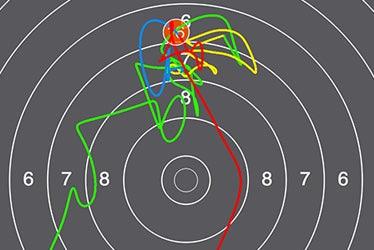For various reasons, each shooter has ever encountered the inability to train at a real distance to the target.
Modern shooting simulators allow to simulate long distance shooting on the shorter distances, even in a small room. In this article we will consider the main points that should be taken into consideration when training at a reduced distance.
To practice at a distance lower than original, the shooter must to print-out a scaled paper target for the actual distance. This case, the angular size of the scaled target should correspond to the size of the original target at the real distance, i.e. visually scaled target should be percept by the shooter as it would looks at the original distance.

1. Original target at the original distance
2 - 4. Scaled target at the reduced distance
A scaled paper target can be printed directly from the SCATT software, where the distance to the target should be the distance from the optical sensor's lens to the location where the paper target is planned to be placed. For more comfortable perception of the target at a short distance, we recommend to printing out a paper target without the scoring rings.
Often, during practice at a short distance to the target, the parallax problem between the gun's sighting line and the the optical sensor's axis becomes an actual problem. To compensate for the parallax, you can use a special mount with possibility of allignment angle change. The main point you shall to pay your attention is that during aiming to the target, optical sensor's aiming point must be displays in the middle of the work area of the optical's sensor calibration window of the SCATT software.

- Gun's barrel
- SCATT optical sensor
- Gun's sight axis
- SCATT optical sensor's axis
- Target
- Mounting prism with parallax compensation possibility
Further practice runs as well, as it was on the real distance to the target. The SCATT software automatically recalculates the angular fluctuations of the aiming point, depending on the simulated distance.



